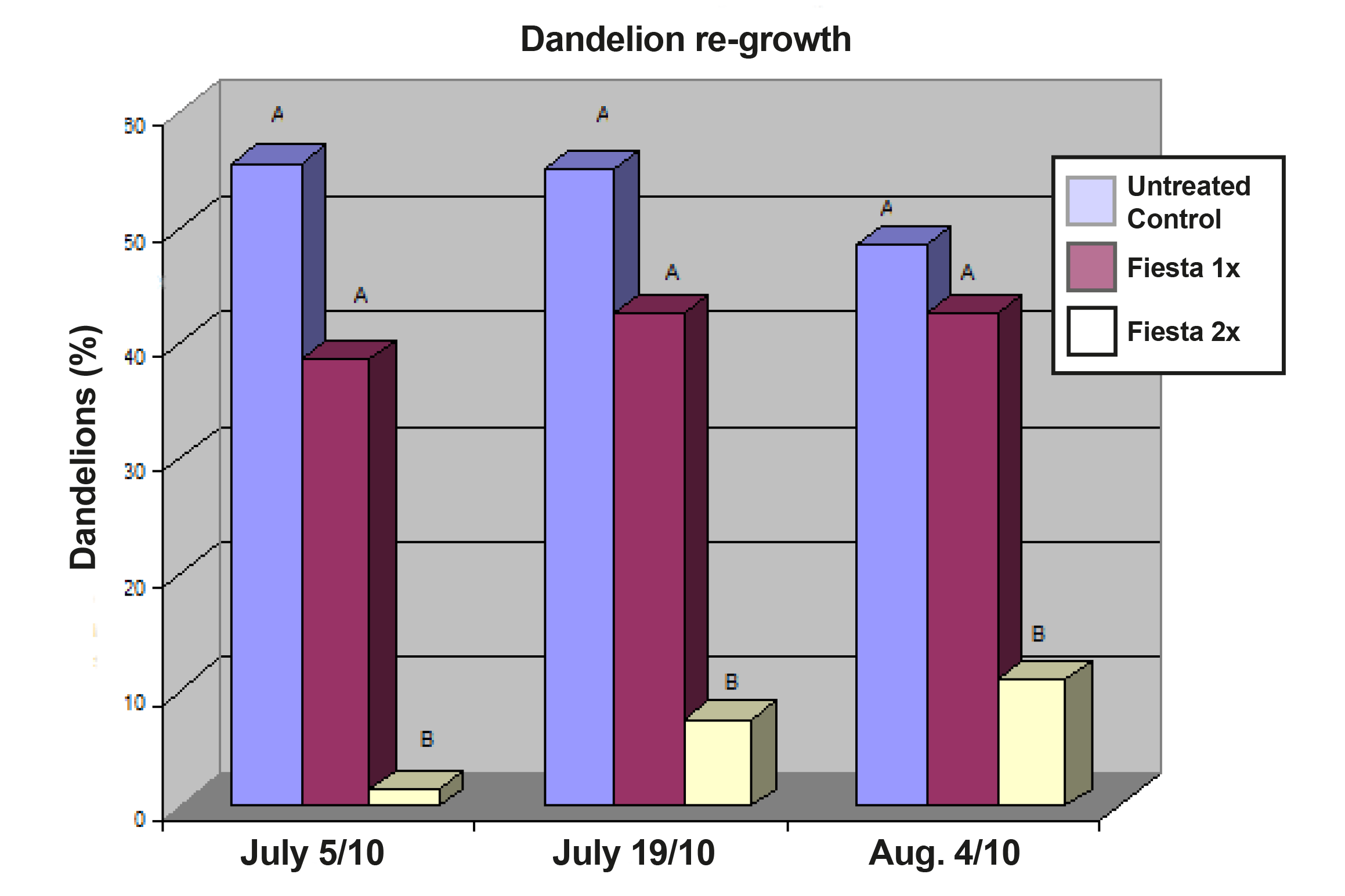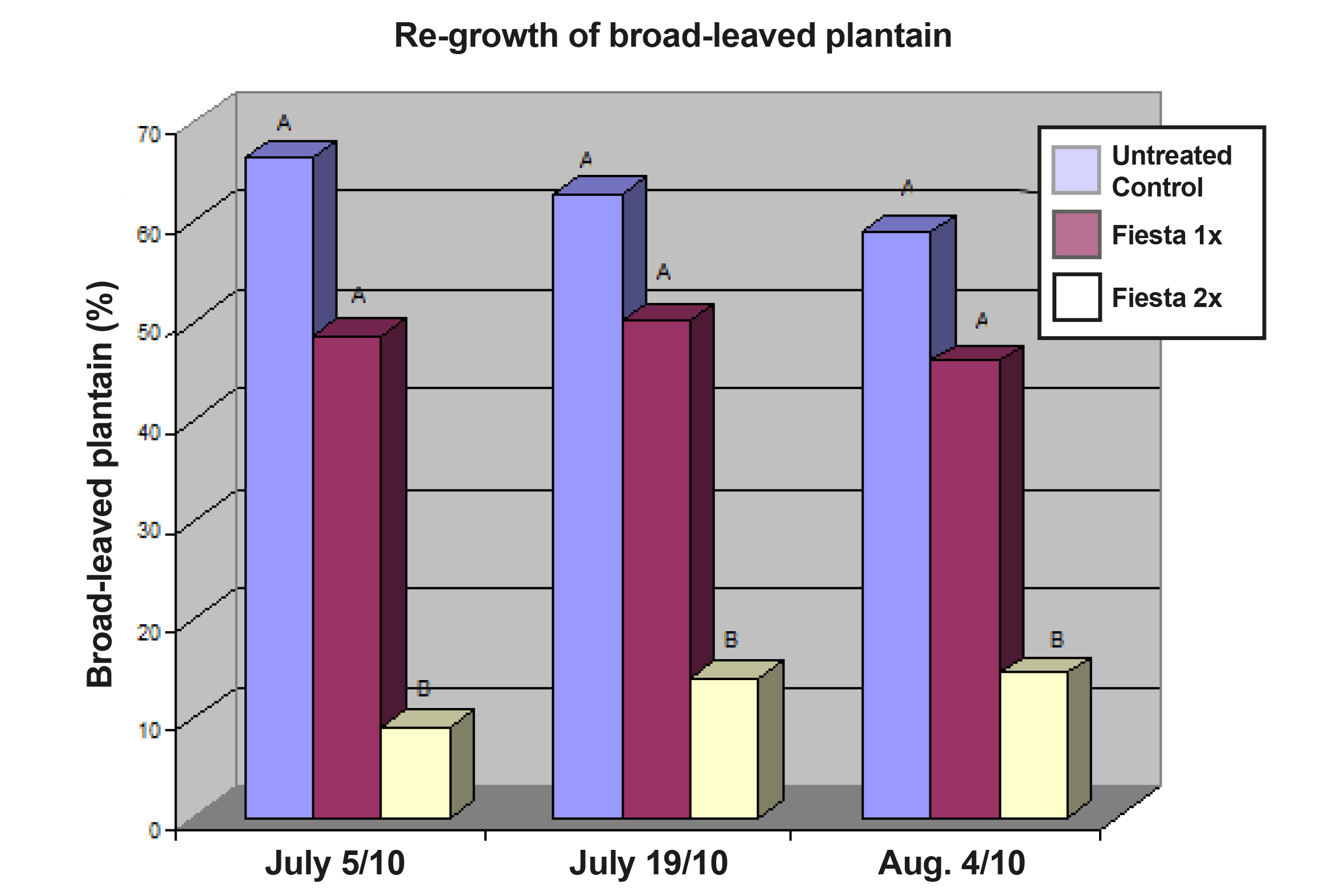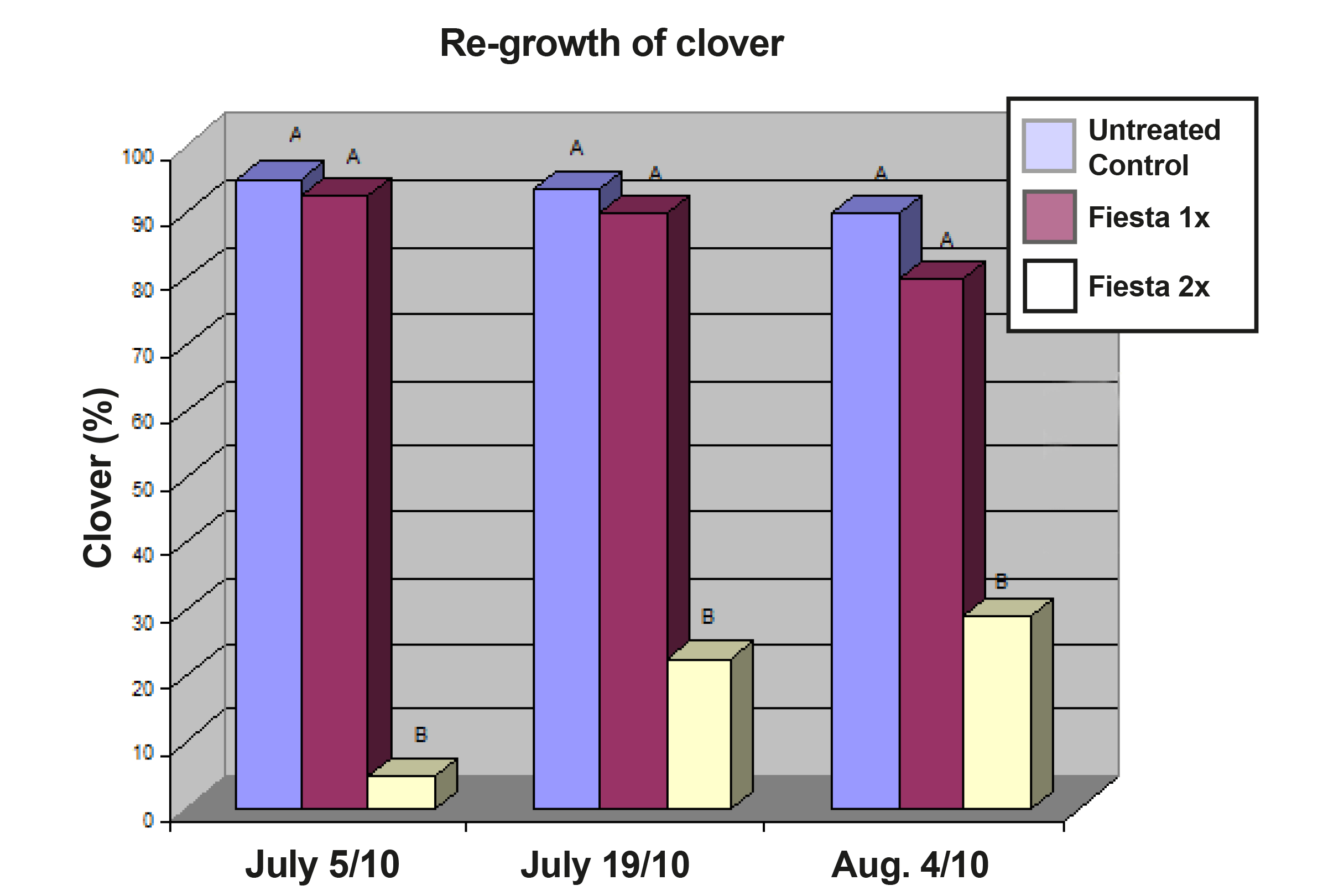January 15, 2012
Weed re-growth with Fiesta herbicide
By Pam Charbonneau
OMAFRA Turfgrass Specialist
When Fiesta received Canadian registration in spring of 2010, there was not a lot of information available on its efficacy on common Ontario lawn weeds.
Some of my duties include validation of turf research for our local conditions. Based on preliminary research in the fall of 2009 on Fiesta, when we were only able to make a single application, we found there was significant re-growth of dandelions at the 200, 400 and 800 mL per 100 sq. m. rate. The re-growth of black medick after one application of Fiesta in the fall was rate dependent and the highest rate (800 mL per 100 sq. m. had the least amount of re-growth, and the lowest rate 200 per 100 sq. m. had the most re-growth). There was very little re-growth of narrow-leaved plantain, regardless of the rate of Fiesta.
 Figure 1. Re-growth of dandelions with one or two applications of Fiesta compared to the untreated control. Bars within each rating date that have the same letter are not significantly different from one another.
Figure 1. Re-growth of dandelions with one or two applications of Fiesta compared to the untreated control. Bars within each rating date that have the same letter are not significantly different from one another.
The data in Figure 1 shows that one month after the first application of Fiesta, the dandelions had significant re-growth and were back to the same per cent of weed cover within the squares as the untreated control. One week after the second treatment of Fiesta, dandelions were almost completely dead. By the last rating date of Aug. 4, 2010, dandelion cover was up to ten per cent within the weed frames. This indicates that two applications of Fiesta are needed for dandelions. Even with the two applications within four weeks of each other, there was re-growth up to ten per cent of the weed frame. This represents an 80 per cent reduction of dandelion over the untreated control.
 Figure 2. Re-growth of broad-leaved plantain with one or two applications of Fiesta compared to the untreated control.
Figure 2. Re-growth of broad-leaved plantain with one or two applications of Fiesta compared to the untreated control.
Results in Figure 2 show that one application of Fiesta on broad-leaved plantain had very similar results to one application on dandelions. The second application of Fiesta on broad-leaved plantain was not as effective as the second application on dandelions. There was still roughly seven per cent broad-leaf plantain cover in the individual frames of tagged plants. By the last rating date (Aug. 4, 2010), the broad-leaved plantain was up to 13 per cent cover within the individual frames, which represents an 80 per cent reduction of weed cover, compared to the untreated control. In general, Fiesta is less effective in controlling broad-leaf plantain than dandelions.
 Figure 3. Re-growth of narrow-leaved plantain with one or two applications of Fiesta, compared to the untreated control.
Figure 3. Re-growth of narrow-leaved plantain with one or two applications of Fiesta, compared to the untreated control.
Results in Figure 3 show that one application of Fiesta significantly reduced the per cent of narrow-leaved plantain well over 50 per cent, and there was no significant re-growth over the three rating dates (July 5, July 19 and Aug. 4, 2010). In addition, two applications of Fiesta reduced the per cent of narrow-leaved plantain to a point where the weed was almost undetectable.
 Figure 4. Re-growth of clover with one or two applications of Fiesta, compared to the untreated control.
Figure 4. Re-growth of clover with one or two applications of Fiesta, compared to the untreated control.
Again, results of the individual clover squares were similar to the broad-leaved plantain. One application of Fiesta on clover had almost no effect at all on the percentage of clover within the frames (Figure 4). One week after the second application of Fiesta, the per cent of clover was significantly reduced, but at the time of the final rating date (Aug. 4, 2010), the clover had re-grown to just under 30 per cent cover, which is a 68 per cent reduction of weed cover from the untreated control.
In 2011, it was demonstrated that two applications of Fiesta were necessary to control both prostrate knotweed and common chickweed, but that the control was much better on the common chickweed. As with all of the weeds tested in 2010 and 2011, with the exception of narrow-leaved plantain, two applications of Fiesta were necessary to control dandelion, broad-leaved plantain, clover, prostrate knotweed and common chickweed. Even with the two Fiesta applications, these weed species are not completely eliminated from within the weed frames. This demonstrates that control of these weeds may take more than two applications per season, or more than one season.
Pam Charbonneau may be contacted at 519-824-4120, ext. 52597, or by e-mail at pamela.charbonneau@ontario.ca.
OMAFRA Turfgrass Specialist
When Fiesta received Canadian registration in spring of 2010, there was not a lot of information available on its efficacy on common Ontario lawn weeds.
Some of my duties include validation of turf research for our local conditions. Based on preliminary research in the fall of 2009 on Fiesta, when we were only able to make a single application, we found there was significant re-growth of dandelions at the 200, 400 and 800 mL per 100 sq. m. rate. The re-growth of black medick after one application of Fiesta in the fall was rate dependent and the highest rate (800 mL per 100 sq. m. had the least amount of re-growth, and the lowest rate 200 per 100 sq. m. had the most re-growth). There was very little re-growth of narrow-leaved plantain, regardless of the rate of Fiesta.
Experimental design 2010
To add to our knowledge about this product, we initiated a tagged weed trial of individual weeds (30 of each species) of clover, narrow-leaved plantain, broad-leaved plantain and dandelion. For narrow and broad-leaved plantain and dandelion, we removed all but one weed per 20 cm x 20 cm frame, and applied one application of Fiesta to ten individual weeds, two applications of Fiesta to ten individual weeds and ten individual weeds went untreated. For clover, we chose patches of clover and put the frames over a patch as it was difficult to determine what constituted an individual plant. Fiesta was diluted according to the label (one part Fiesta to 24 parts water) and applied with a backpack sprayer until the weeds were thoroughly wet. The two applications of Fiesta as a spot treatment on individual weeds is the common method of application adopted by the lawn care sector. The percentage of weed cover within the frame was visually estimated and recorded at each rating date.Experimental design 2011
In 2011, we initiated a tagged trial of individual weeds of common chickweed and patches of prostrate knotweed (30 of each species) and performed a similar trial to the one conducted in 2010 to determine the susceptibility to Fiesta where ten weed frames received one application of Fiesta, ten weed frames received two applications of Fiesta and ten were left untreated. Fiesta was diluted according to the label (one part Fiesta to 24 parts water) and applied with a backpack sprayer until the weeds were thoroughly wet. The percentage of weed cover within the weed frame was estimated visually and recorded at each rating date. Only the data from July 11, 2011 will be reported, because it represents that collected after the two applications of Fiesta.2010 results
 Figure 1. Re-growth of dandelions with one or two applications of Fiesta compared to the untreated control. Bars within each rating date that have the same letter are not significantly different from one another.
Figure 1. Re-growth of dandelions with one or two applications of Fiesta compared to the untreated control. Bars within each rating date that have the same letter are not significantly different from one another.
The data in Figure 1 shows that one month after the first application of Fiesta, the dandelions had significant re-growth and were back to the same per cent of weed cover within the squares as the untreated control. One week after the second treatment of Fiesta, dandelions were almost completely dead. By the last rating date of Aug. 4, 2010, dandelion cover was up to ten per cent within the weed frames. This indicates that two applications of Fiesta are needed for dandelions. Even with the two applications within four weeks of each other, there was re-growth up to ten per cent of the weed frame. This represents an 80 per cent reduction of dandelion over the untreated control.
 Figure 2. Re-growth of broad-leaved plantain with one or two applications of Fiesta compared to the untreated control.
Figure 2. Re-growth of broad-leaved plantain with one or two applications of Fiesta compared to the untreated control.
Results in Figure 2 show that one application of Fiesta on broad-leaved plantain had very similar results to one application on dandelions. The second application of Fiesta on broad-leaved plantain was not as effective as the second application on dandelions. There was still roughly seven per cent broad-leaf plantain cover in the individual frames of tagged plants. By the last rating date (Aug. 4, 2010), the broad-leaved plantain was up to 13 per cent cover within the individual frames, which represents an 80 per cent reduction of weed cover, compared to the untreated control. In general, Fiesta is less effective in controlling broad-leaf plantain than dandelions.
 Figure 3. Re-growth of narrow-leaved plantain with one or two applications of Fiesta, compared to the untreated control.
Figure 3. Re-growth of narrow-leaved plantain with one or two applications of Fiesta, compared to the untreated control.
Results in Figure 3 show that one application of Fiesta significantly reduced the per cent of narrow-leaved plantain well over 50 per cent, and there was no significant re-growth over the three rating dates (July 5, July 19 and Aug. 4, 2010). In addition, two applications of Fiesta reduced the per cent of narrow-leaved plantain to a point where the weed was almost undetectable.
 Figure 4. Re-growth of clover with one or two applications of Fiesta, compared to the untreated control.
Figure 4. Re-growth of clover with one or two applications of Fiesta, compared to the untreated control.
Again, results of the individual clover squares were similar to the broad-leaved plantain. One application of Fiesta on clover had almost no effect at all on the percentage of clover within the frames (Figure 4). One week after the second application of Fiesta, the per cent of clover was significantly reduced, but at the time of the final rating date (Aug. 4, 2010), the clover had re-grown to just under 30 per cent cover, which is a 68 per cent reduction of weed cover from the untreated control.
Results 2011
Results obtained on common chickweed show that one application of Fiesta rated six weeks after the first application (on May 30) reduced the weed cover by roughly 50 per cent and two applications rated two weeks after the second application (June 27), reduced the per cent cover to five per cent, which is an 88 per cent reduction. Results for prostrate knotweed were very similar. Fiesta herbicide applied once, reduced the per cent of weed cover in the weed frame from 86 per cent to 54 per cent, which is a 36 per cent reduction. The second application of Fiesta reduced the percentage of weed cover in the weed frame to 18 per cent.Conclusions
Data from 2010 on individual tagged weeds of dandelion, broad-leaved plantain and clover shows a significant re-growth of these weed species with a single application of Fiesta. Narrow-leaf plantain is more susceptible to Fiesta, and a single application gives control significantly better than the untreated control, while two applications of Fiesta gave almost 100 per cent control of this weed species. Patches of clover treated once with Fiesta did not show a significant reduction in clover within the weed frames. After the second Fiesta application, there was significant reduction in per cent of dandelion cover, and per cent of broad-leaf plantain, which represented an 80 per cent reduction over the untreated control, but did represent re-growth from the ratings that were taken within a week of the second Fiesta application. After the second Fiesta application, there was an immediate reduction in the per cent of clover, but by the Aug. 4, the per cent of clover cover was up to 27, showing there was also re-growth of clover.In 2011, it was demonstrated that two applications of Fiesta were necessary to control both prostrate knotweed and common chickweed, but that the control was much better on the common chickweed. As with all of the weeds tested in 2010 and 2011, with the exception of narrow-leaved plantain, two applications of Fiesta were necessary to control dandelion, broad-leaved plantain, clover, prostrate knotweed and common chickweed. Even with the two Fiesta applications, these weed species are not completely eliminated from within the weed frames. This demonstrates that control of these weeds may take more than two applications per season, or more than one season.
Pam Charbonneau may be contacted at 519-824-4120, ext. 52597, or by e-mail at pamela.charbonneau@ontario.ca.